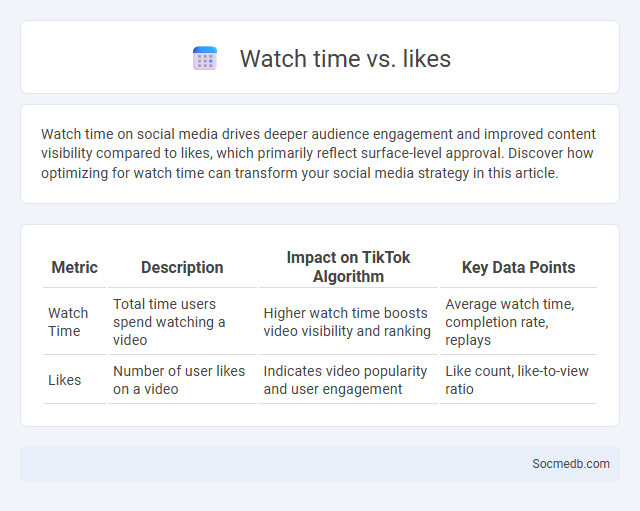
Photo illustration: watch time vs likes
Watch time on social media drives deeper audience engagement and improved content visibility compared to likes, which primarily reflect surface-level approval. Discover how optimizing for watch time can transform your social media strategy in this article.
Table of Comparison
| Metric | Description | Impact on TikTok Algorithm | Key Data Points |
|---|---|---|---|
| Watch Time | Total time users spend watching a video | Higher watch time boosts video visibility and ranking | Average watch time, completion rate, replays |
| Likes | Number of user likes on a video | Indicates video popularity and user engagement | Like count, like-to-view ratio |
Understanding Watch Time: Definition and Importance
Watch time measures the total minutes users spend viewing video content on social media platforms, serving as a critical metric for engagement analysis. Higher watch time signals content relevance and quality, influencing algorithmic promotion and increasing organic reach. Brands and creators optimize watch time to boost visibility, improve audience retention, and drive meaningful interactions across platforms like YouTube, Instagram, and TikTok.
Decoding Likes: What Do They Really Mean?
Likes on social media serve as a quantifiable metric reflecting user engagement, signaling approval, interest, or social validation. These interactions influence content visibility through algorithmic prioritization, shaping user experience and platform dynamics. Understanding the nuanced motives behind likes reveals insights into audience behavior, marketing effectiveness, and digital communication patterns.
Watch Time vs Likes: Key Differences
Watch time measures the total amount of time viewers spend watching videos, highlighting engagement depth and content retention. Likes represent user approval and quick feedback but do not reflect how long users interact with the video. Platforms prioritize watch time in their algorithms to boost meaningful content visibility over mere popularity indicated by likes.
The Impact of Watch Time on Algorithm Rankings
Watch time is a critical factor that influences social media algorithm rankings by measuring how long users engage with content, indicating its relevance and quality. Platforms prioritize videos and posts with higher watch times, boosting their visibility and reach within your network. Optimizing content to maximize watch time can significantly enhance your social media presence and engagement rates.
How Audience Engagement Affects Likes and Watch Time
Audience engagement directly influences social media likes and watch time by boosting content visibility through algorithmic preferences. High engagement rates signal relevant and compelling posts, prompting platforms to prioritize them in users' feeds and recommendations. Increased interactions such as comments, shares, and reactions extend content reach, resulting in higher likes and longer watch durations.
The Role of Thumbnails and Titles in Increasing Watch Time
Thumbnails and titles play a crucial role in increasing watch time on social media platforms by capturing viewers' attention and setting clear expectations about the video content. High-quality, visually engaging thumbnails combined with concise, keyword-rich titles improve click-through rates and encourage viewers to stay longer. Optimizing these elements enhances algorithmic recommendations, boosting video visibility and overall engagement.
Why Watch Time Outweighs Likes for Content Creators
Watch time significantly impacts content creators by enhancing video ranking algorithms, leading to greater visibility and organic reach on platforms like YouTube. Your audience engagement through longer watch durations signals valuable content, which increases ad revenue opportunities and subscriber growth. Unlike likes, watch time directly influences the platform's promotion of your videos, making it a crucial metric for sustained success.
Strategies to Boost Both Watch Time and Likes
Creating engaging content that resonates with your target audience helps increase both watch time and likes on social media platforms like YouTube and Instagram. Utilizing compelling thumbnails, clear calls-to-action, and interactive features such as polls or questions encourages viewer participation and retention. Consistently analyzing performance metrics and adjusting content strategies based on data insights optimizes engagement and boosts algorithm-driven visibility.
Common Misconceptions About Watch Time and Likes
Many users mistakenly believe that watch time directly correlates with likes, but these metrics measure different aspects of engagement. Watch time reflects content retention and viewer interest, while likes indicate immediate approval and can be influenced by various factors, including social trends. Understanding how YouTube and other platforms analyze these separate signals helps optimize your content strategy for better reach and audience retention.
Watch Time Metrics: Interpreting Data for Success
Watch time metrics on social media platforms provide critical insights into audience engagement and content performance, directly influencing algorithmic promotion and reach. Analyzing your watch time helps identify which videos retain viewers and drive higher interaction rates, guiding content strategy adjustments. Understanding these patterns enables you to optimize video length and quality, maximizing retention and boosting overall success.
 socmedb.com
socmedb.com